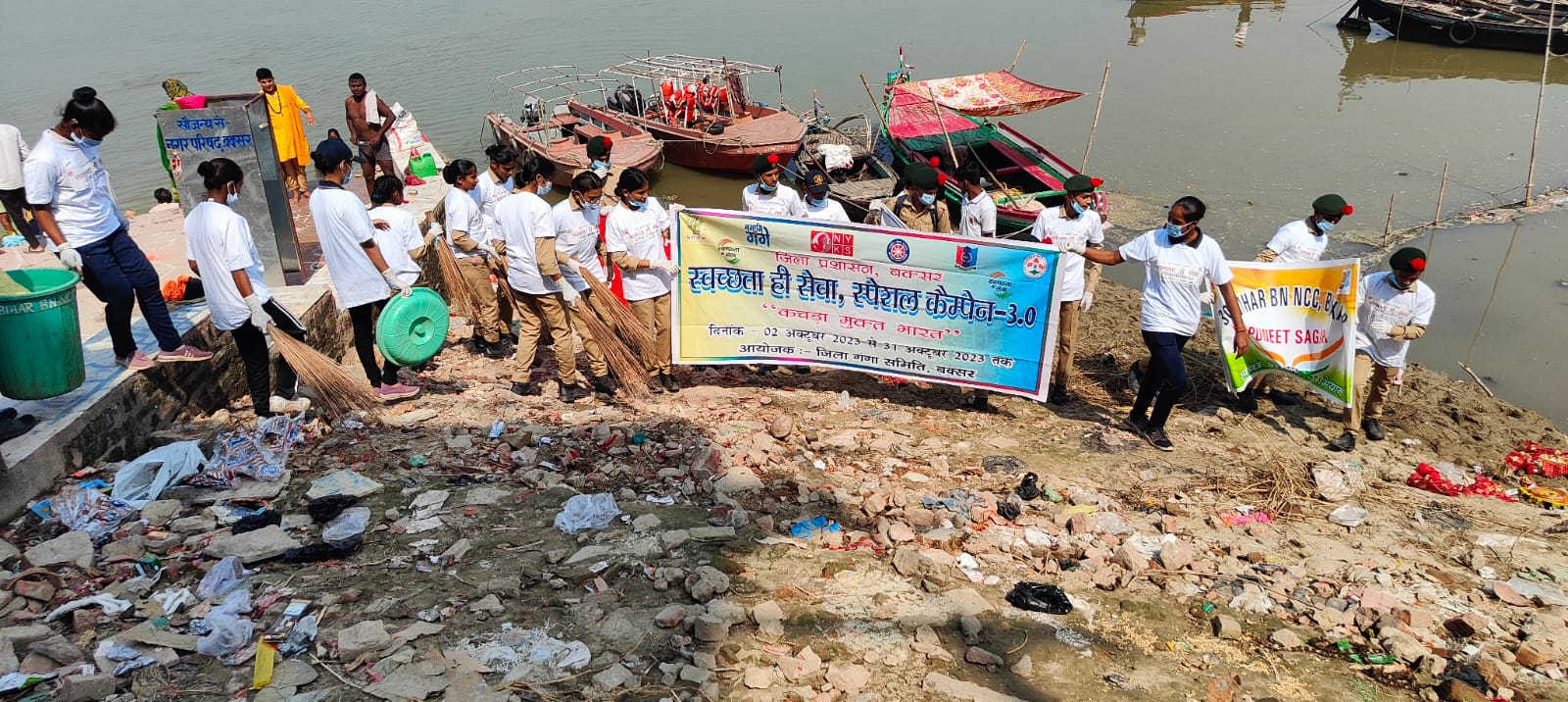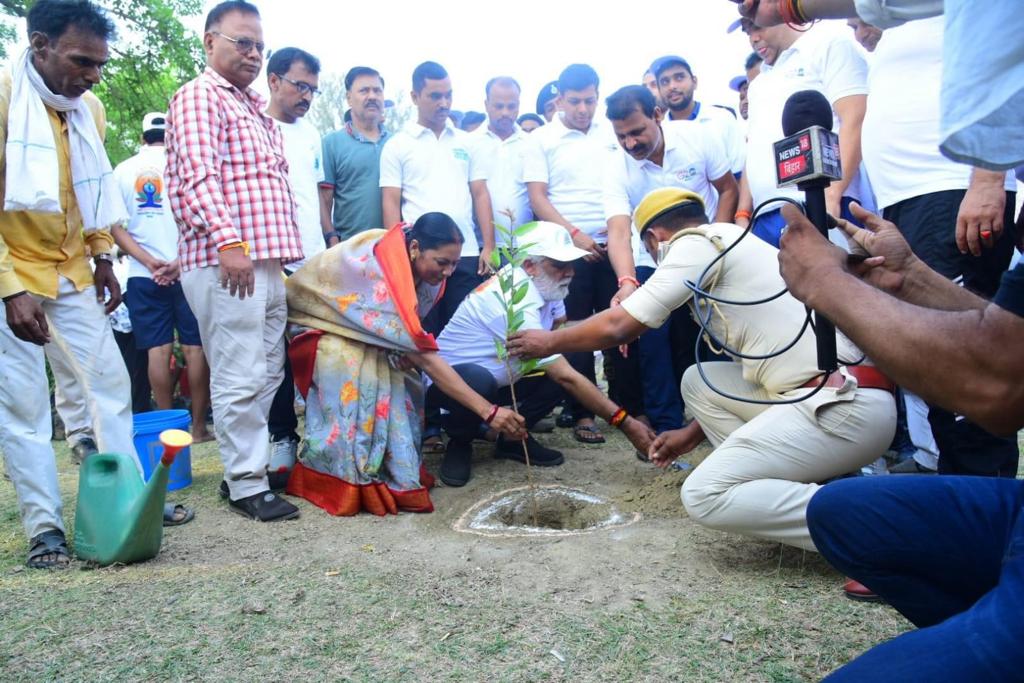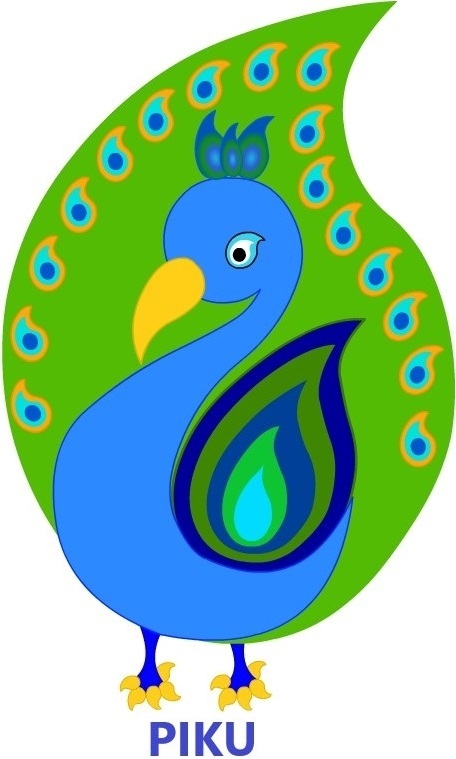Under the National Mission for Clean Ganga, different initiatives are encouraged to inform people to keep the Ganga and its surroundings clean. Volunteers from the locality are identified and encouraged to make Ganga ghats clean and plastic-free. Cleanliness drives, oath-taking programs and rallies are arranged in Ganga villages to attract many people to the cause. Boat races and different sports activities are organized along Ganga ghat to convey the message of Ganga cleanliness among youth and local people. During Chhat and other big congregations at Ganga Ghats, boats are deployed with personnel to communicate the message of the cleanliness of the river and ghat. and Dustbins are kept along the Ganga River in Simri block. Ratri-Chaupal and Mashal yatra are organized to encourage personal connection with the Ganga River and discuss local initiatives to keep the Ganga clean. NCC cadets, school and college students are engaged in painting competitions and seminars to create awareness among young minds. Catch the Rain program is promoted for rainwater harvesting. Water conservation is an important topic of Weekly Group discussions organized by Jeevika Didis. Few Self Help Groups are taking care of ponds by adopting the profession of fishing. They regularly clean it, report and check encroachments and also introduce fishlings and water nutrients to keep ponds ecologically vibrant. Jeevika Didis has also established plant nurseries and is playing a vital role in taking the message of water conservation and afforestation to the last mile. In another effort, 1.5 lakh fishlings were introduced in the Ganga River to support the livelihoods of many poor as well as check pollution in the River.
The Jal-Jeevan-Hariyali Mission of Bihar Government keeps water resource conservation initiatives at its core. Buxar stands at second/ first position in the whole state by putting a special focus on the development and regeneration of water bodies. The awareness component of this Mission has brought every concerned department to one table where they decided to integrate their efforts to bring a tangible change in water bodies. This Mission makes people aware of the indispensability of the Trinity of Jal-Jeevan-Hariyali in their lives.
After its rejuvenation under the MGNREGA Scheme, the micro-irrigation department and soil conservation department encouraged people to plant saplings along Ahar-Pynes and ponds boundaries to strengthen its boundaries, which further helps in the percolation of water and groundwater recharge. Krishi Vigyan Kendras is encouraging farmers to adopt organic farming to minimize water pollution and water use. The Soil Conservation Department has made many farmers aware of the importance of rainwater harvesting and optimal use of water resources through Nukkad-Natak, slogan writing and wall paintings. This department is making Soil Health Cards which reflect the soil moisture content of fields and hence promote farmers towards climate-friendly farming practices. Many farmers learned considerably through the demonstration of water conservation techniques in agriculture under the Climate Resilient Agriculture Programme (CRAP) like zero tillage wheat, alternating drying and wetting in rice, water harvesting structures and field bunding of rice, and direct seeded of rice. Demonstration of water conservation techniques in agriculture, like digging of Farm Ponds of different dimensions by farmers, under the National Innovation on Climate Resilient Agriculture (NICRA) have benefitted many farmers. Demonstrations of rainwater harvesting structures (farm ponds) have benefitted 55 farmers who have developed farm ponds of different dimensions with a 27.8-hectare total area and 161 lakh liters of water storage capacity.
Buxar district is blessed with a long stretch of Ganga river and various traditional water bodies like Ahar-Pynes and ponds. Network of these water bodies in the district requires its conservation as well as preservation of its purity and cleanliness in its surroundings. Along the Ganga ghats, lakhs of people come to celebrate many festivals like Chhat, Ganga Dussehra, etc. whole year leading to pollution along the ghats. Ahar-Pynes and ponds are major sources of irrigation in Buxar and their timely rejuvenation makes them viable to hold excess water in monsoon and recharge groundwater. Buxar, which has an agro-based economy, is famous for its Sonachur rice cultivation which is a water-guzzling crop. On-farm misuse of water and wrong choice of crops also lead to water wastage. Hence, here main intervention required is to inform local people about the cruciality of these water bodies in our lives and how their cleanliness and conservation would help in sustainable development. Therefore, a strong apparatus of awareness campaign is needed to engage every section of people benefitting from these water bodies directly or indirectly. Active participation of people is required in the conservation of the sanctity of water bodies to bring sustainable behavior change.
Based on the background given, the aim of the initiative is the convergence of different schemes and departments for creating awareness at a large scale about the conservation and preservation of a huge network of water bodies in Buxar. Convergence of efforts of National Mission for Clean Ganga, PM Krishi Sinchayi Yojana, Krishi Vigyan Kendras, MGNREGA, Panchayati Raj department, forest department, education department, minor irrigation department as well as a huge force of Jeevika Didis. These departments and organizations have regular interaction with farmers, students, women, rural population, etc., who have a heavy dependence on water resources as well as who have the potential to become ambassadors of water conservation. Streamlined efforts of these departments can create ripple effects in society for conservation and wise use of water. Awareness created by them will help local people to ensure cleanliness along Ganga ghats and ponds, keeping Ahar-Pynes encroachment-free, and sustainable use of water in agriculture fields.
The awareness programmes and different initiatives helped in the active participation of people to understand the importance of water conservation. Proper use of dustbins along Ganga ghat in Simri which helps in controlling pollution of the river. Through the active participation of youth, a cadre of Ganga doots has been strengthened to ensure regular awareness programmes among local people. Forest department has developed Kamaldah Pokhar Park, which has become a tourist spot in Buxar city. A total of 543 pounds (pokhar), 680 Ahars and 3382 Pynes were rejuvenated under the Jal-Jeevan-Hariyali Mission in Buxar. Krishi Vigyan Kendras has made 4408 Soil Health Cards. The fisheries department is maintaining the cleanliness of this Pokhara and is hence playing a major role in recharging depleting groundwater levels in urban areas. People are volunteering to maintain the cleanliness of Ganga ghats and ponds. Farmers and poor agriculture laborers are appreciating equitable access to water for irrigating their fields. The rejuvenation of Ahar-Pynes and ponds has helped in strengthening its embankments and increasing the catchment area of water.
The basic line of thought is to ensure effective and targeted communication of water conservation messages through the active participation of students, farmers, habitants of Ganga villages, Jeevika Didis, etc. Their lives and livelihoods are dependent on water bodies, and they are also worried about the depleting condition of these water resources. Hence any intervention that carries a message of their sustainable future will be hurriedly received by them. Therefore, through different schemes and departments specific groups are targeted to bring behavioural change as well as for bringing changes on the ground. Jal Doots, Jal Kalash Yatras, Mashal yatras, plant adoption by students, etc. efforts are planned to make society more aware of the necessity of the cause. International Yoga Day was celebrated along the clean ghats of Ganga, which conveyed the message of water conservation. Innovative steps are focussing on creating a sense of attachment to water bodies among people so that they can own the responsibility of water conservation. The strength of the community is utilized to bring water to the center of discussion and action. So, regularly nudging people to think about water and its importance will ultimately bring a huge transformation in their actions.












